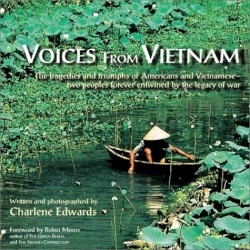Voices from Vietnam
The tragedies and triumphs of Americans and Vietnamesetwo people forever entwined by the legacy of war
Perhaps the most famous photograph of the Vietnam War was that of terrified children running from an aerial napalm attack in June 1972. One of them was nine-year-old Kim Phuc, naked and in agony as napalm seared her body. Now living in Toronto with her husband and two sons, Kim was one of seventy Vietnamese and Americans that the author interviewed during a decade of research.
Edwards writes that 58,000 Americans were killed in Vietnam and that four million VietnameseÃ’soldiers and civiliansÃ’were killed or wounded. She found that the countryside still contains unexploded bombs and hand grenades and that eleven million gallons of the defoliant Agent Orange were left behind, causing children to be born with defects. Edwards talked with soldiers (including former POWs), nurses, refugees, Amerasians whose fathers are American and mothers are Vietnamese, religious leaders, and Highlanders, who live in sparsely populated mountainous regions of the country. Some of the book’s most stunning photographs are of the Highlanders in their remote villages.
One of the most poignant interviews is with a survivor of four jungle prison camps whose Huey gunship was shot down. The crash smashed his knees and compressed several vertebrae and marked the beginning of a five-year odyssey in which many of his fellow prisoners died. “Life in the prisoner of war camps debilitated the body, the mind, and the spirit,” Edwards writes, “and turned civilized human beings into primal animals whose only struggle was to simply stay alive.”
Also interviewed is an Amerasian girl whose father never came back for her, an American soldier who was wounded three times and each time sent back into battle, a Vietnamese Navy frogman who discovered and removed three mines attached to a United States Navy ship, saving thousands of lives, and a former commander of the Viet Cong who was one of the planners of the Tet Offensive in 1968.
All but a few of the 172 photographs were taken by Edwards. Robin Moore, author of The Green Berets and The French Connection, wrote a foreword to the book. Through these graphic narratives and photographs, Edwards has created a lasting tribute to all those who suffered in a war that neither side won.
Reviewed by
George Cohen
Disclosure: This article is not an endorsement, but a review. The publisher of this book provided free copies of the book to have their book reviewed by a professional reviewer. No fee was paid by the publisher for this review. Foreword Reviews only recommends books that we love. Foreword Magazine, Inc. is disclosing this in accordance with the Federal Trade Commission’s 16 CFR, Part 255.

